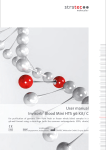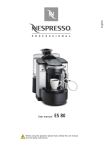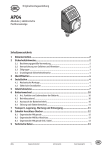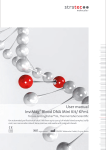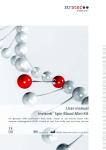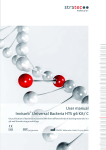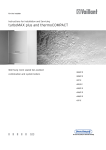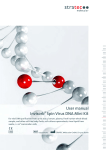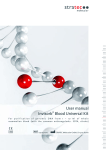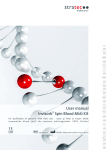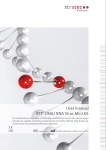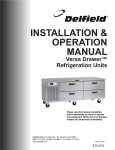Download Invisorb Blood Mini HTS 96 Kit/ C User manual
Transcript
User manual Invisorb® Blood Mini HTS 96 Kit/ C For purification of genomic DNA from fresh or frozen whole blood samples in a 96-well format using a centrifuge (with the common anticoagulants: EDTA, citrate) IVD 7031800x00 REF 7031300x00 7031900x00 STRATEC Molecular GmbH, D-13125 Berlin Instruction for Invisorb® Blood Mini HTS 96 Kit/ C for use on a centrifuge The Invisorb® Blood Mini HTS 96 Kit is the ideal tool for isolation and purification of highly pure DNA from large numbers of max. 200 µl fresh or frozen, human or mammalian whole blood samples treated with EDTA or citrate in a 96 well format using a centrifuge. The kit is neither validated for the isolation of genomic DNA from cultured or isolated cells, from tissue, dried blood stains and urine nor from stool sample, bacteria, fungi, parasites, or the purification of RNA. The kit is neither suitable for isolation of the DNA from stool samples, tissue samples, bacteria, fungi, plants or viruses nor for purification of RNA. IVD Compliance with EU Directive 98/79/EC on in vitro medical devices Not for in vitro diagnostic use in countries where the EU Directive 98/79/EC on in vitro medical devices is not recognized. Trademarks: Invisorb®, InviMag®. Registered marks, trademarks, etc. used in this document, even when not specifically marked as such, are not to be considered unprotected by law. The Invisorb® technology is covered by patents and patent applications: US 6,110363, US 6,043,354, US 6,037,465, EP 0880535, WO 9728171, WO 9534569, EP 0765335, DE 19506887, DE 10041825.2, WO 0034463. Invisorb® and InviMag® are registered trademarks of STRATEC Biomedical AG. The PCR process is covered by US Patents 4,683,195, and 4,683,202 and foreign equivalents owned by Hoffmann-La Roche AG. © 2013 STRATEC Molecular, all rights reserved. ® Invisorb Blood Mini HTS 96 Kit C 0213 Contents Kit contents of Invisorb® Blood Mini HTS 96 Kit/ C Kit contents of Invisorb® Blood Mini HTS 96 Kit/ C (with 8 or 12 -well strips elution plate) Symbols Storage Quality control Intended use Product use limitation Safety information Product characteristic of the Invisorb® Blood Mini HTS 96 Kit Sampling and sample storage of the starting material Principle and procedure Yield and quality of genomic DNA Important notes Important points before starting a protocol Preparing reagents and buffers Reagents and equipment to be supplied by user Important indications Scheme - Invisorb® Blood Mini HTS 96 Kit/ C & Invisorb® Blood Mini HTS 96 Kit/ C (with 8 well strips elution plate) Preparing reagents & buffers for Invisorb® Blood Mini HTS 96 Kit/ C Protocol 1: Isolation of genomic DNA from up to 200 µl of whole blood or 1 – 30 µl buffy coat Protocol 2: Isolation of genomic DNA from up to 25 µl of non mammalian blood Protocol 3: Isolation of genomic DNA from CFS and bone marrow Protocol 4: Isolation of genomic DNA from swabs or rinsed liquid from swabs Invisorb® Blood Mini HTS 96 Kit/ C (with 12 well strips elution plate) Protocol 1c: Isolation of genomic DNA from up to 200 µl of whole blood or 1 – 30 µl buffy coat Troubleshooting Appendix Ordering information ® 3 4 5 5 5 6 6 7 8 9 9 10 11 11 11 12 12 13 14 15 16 16 17 18 20 23 24 Invisorb Blood Mini HTS 96 Kit C 0213 Kit contents of Invisorb® Blood Mini HTS 96 Kit/ C Store diluted Proteinase K at - 20°C Store all other kit components at room temperature (RT)! 2 x 96 extractions 4 x 96 extractions 24 x 96 extractions 7031300200 7031300300 7031300400 50 ml 90 ml 500 ml for 2 x 2ml working solution 2 x 8 ml (final volume 2 x 32 ml) 80 ml (final volume 160 ml) for 4 x 2 ml working solution 30 ml (final volume 120 ml) 125 ml (final volume 250 ml) for 50 ml working solution 130 ml (final volume 520 ml) 2 x 400 ml final vol. 2 x 800 ml Wash Buffer II 2 x 45 ml (final volume 2 x 150 ml) 3 x 60 ml (final volume 3 x 200 ml) 4 x 300 ml final vol. 4 x 1000 ml Elution Buffer 60 ml 90 ml 500 ml DNA Binding Plate C 2 4 6x4 2 ml Collection Plate 4 2x4 12 x 4 Elution Plate L 2 4 24 Sealing Foils 6 12 72 Plate Lid 2 4 24 Manual 1 1 1 Add 24 ml 99.7% Isopropanol to each Binding Buffer HL. Mix by intensive shaking by inverting for 1 min. Shortly before use mix by inverting several times. Add 90 ml 99.7% Isopropanol to the Binding Buffer HL. Mix by intensive shaking by inverting for 1 min. Shortly before use mix by inverting several times. Dilute Proteinase K by addition of 2 ml of ddH2O, mix thoroughly and store like described below! Dilute Proteinase K by addition of 2 ml of ddH2O, mix thoroughly and store like described below! Add 80 ml of 96 % - 100 % ethanol to the bottle Wash Buffer I, mix thoroughly and always keep the bottle firmly closed! Add 125 ml of 96 % - 100 % ethanol to the bottle Wash Buffer I, mix thoroughly and always keep the bottle firmly closed! Add 105 ml of 96 % - 100 % ethanol to the bottle Wash Buffer II, mix thoroughly and always keep the bottle firmly closed! Add 140 ml of 96 % - 100 % ethanol to each bottle Wash Buffer II, mix thoroughly and always keep the bottle firmly closed! Catalogue No. Lysis Buffer HL Proteinase K Binding Buffer HL Wash Buffer I Initial steps Add 390 ml 99.7% Isopropanol to the Binding Buffer HL. Mix by intensive shaking by inverting for 1 min. Shortly before use mix by inverting several times. Dilute Proteinase K by addition of 50 ml of ddH2O, mix thoroughly and store like described below! Add 400 ml of 96 % - 100 % ethanol to each bottle Wash Buffer I, mix thoroughly and always keep the bottle firmly closed! Add 700 ml of 96 % - 100 % ethanol to each bottle Wash Buffer II, mix thoroughly and always keep the bottle firmly closed! ® Invisorb Blood Mini HTS 96 Kit C 0213 Kit contents of Invisorb® Blood Mini HTS 96 Kit/ C (with 8 or 12 well strips elution plate) Store diluted Proteinase K at - 20°C! Store all other kit components at room temperature (RT)! 2 x 96 extractions 4 x 96 extractions 24 x 96 extractions 7031900200 7031900300 7031900400 7031800200 7031800300 7031800400 50 ml 90 ml 500 ml for 2 x 2ml working solution for 4 x 2 ml working solution for 50 ml working solution 2 x 8 ml (final volume 2 x 32 ml) 30 ml (final volume 120 ml) 130 ml (final volume 520 ml) Wash Buffer I 80 ml (final volume 160 ml) 125 ml (final volume 250 ml) 2 x 400 ml final vol. 2 x 800 ml Wash Buffer II 2 x 45 ml (final volume 2 x 150 ml) 3 x 60 ml (final volume 3 x 200 ml) 4 x 300 ml final vol. 4 x 1000 ml Elution Buffer 60 ml 90 ml 500 ml DNA Binding Plate C 2 4 24 2 ml Collection Plate 4 8 48 1 x 2 or 1 x 2 1 x 4 or 1 x 4 6 x 4 or 6 x 4 24 or 16 48 or 32 288 or 192 Cap Mat 4 8 48 Plate Lid 2 4 24 Manual 1 1 1 Add 24 ml 99.7% Isopropanol to each Binding Buffer HL. Mix by intensive shaking by inverting for 1 min. Shortly before use mix by inverting several times. Add 90 ml 99.7% Isopropanol to the Binding Buffer HL. Mix by intensive shaking by inverting for 1 min. Shortly before use mix by inverting several times. Add 390 ml 99.7% Isopropanol to the Binding Buffer HL. Mix by intensive shaking by inverting for 1 min. Shortly before use mix by inverting several times. Dilute Proteinase K by addition of 2 ml of ddH2O, mix thoroughly and store like described below! Dilute Proteinase K by addition of 2 ml of ddH2O, mix thoroughly and store like described below! Catalogue No. Kit with 8 well strips elution plate Catalogue No. Kit with 12 well strips elution plate Lysis Buffer HL Proteinase K Binding Buffer HL Microtube Plate (8 strips elution plate) or (12 strips elution plate) Microtube Cap (8 strips caps) or (12 strips caps) Initial steps Add 80 ml of 96 % - 100 % ethanol to the bottle Wash Buffer I, mix thoroughly and always keep the bottle firmly closed! Add 105 ml of 96 % - 100 % ethanol to the bottle Wash Buffer II, mix thoroughly and always keep the bottle firmly closed! Add 125 ml of 96 % - 100 % ethanol to the bottle Wash Buffer I, mix thoroughly and always keep the bottle firmly closed! Add 140 ml of 96 % - 100 % ethanol to each bottle Wash Buffer II, mix thoroughly and always keep the bottle firmly closed! Dilute Proteinase K by addition of 50 ml of ddH2O, mix thoroughly and store like described below! Add 400 ml of 96 % - 100 % ethanol to each bottle Wash Buffer I, mix thoroughly and always keep the bottle firmly closed! Add 700 ml of 96 % - 100 % ethanol to each bottle Wash Buffer II, mix thoroughly and always keep the bottle firmly closed! ® Invisorb Blood Mini HTS 96 Kit C 0213 Symbols Lot number Catalogue number Date of manufacture Expiry date Consult operating instructions Temperature limitation Do not reuse Storage All buffers and kit contents of the Invisorb® Blood Mini HTS 96 Kit/ C except dissolved Proteinase K should be stored at room temperature and are stable for at least 12 months under these conditions. Proteinase K: Dissolved Proteinase K must be stored at –20°C. Dividing the Proteinase K into aliquots and storage at –20°C is recommended. Wash Buffers: Wash Buffers charged with ethanol should be stored at room temperature and should be appropriate sealed. If there are any precipitates within the provided solutions solve these precipitates by careful warming up to room temperature (up to 30°C). Room temperature (RT) is defined as range from 15 - 30°C. Quality control and product warranty STRATEC Molecular warrants the correct function of the Invisorb® Blood Mini HTS 96 Kit/ C for applications as described in this manual. Purchaser must determine the suitability of the Product for its particular use. Should any Product fail to perform the applications as described in the manual, STRATEC Molecular will check the lot and if STRATEC Molecular investigates a problem in the lot, STRATEC Molecular will replace the Product free of charge. STRATEC Molecular reserves the right to change, alter, or modify any Product to enhance its performance and design at any time. In accordance with STRATEC Molecular’s ISO 9001-2000 and ISO EN 13485 certified Quality Management System the performance of all components of the Invisorb® Blood Mini HTS 96 Kit/ C have been tested separately against predetermined specifications routinely on lot-to-lot to ensure consistent product quality. If you have any questions or problems regarding any aspects of Invisorb® Blood Mini HTS 96 Kit/ C or other STRATEC Molecular products, please do not hesitate to contact us. A copy of STRATEC Molecular’s terms and conditions can be obtained upon request or are presented at the STRATEC Molecular webpage. For technical support or further information please contact: from Germany +49-(0)30-9489-2901/ 2910 from abroad +49-(0)30-9489-2907 or contact your local distributor. ® Invisorb Blood Mini HTS 96 Kit C 0213 Intended use The Invisorb® Blood Mini HTS 96 Kit has been designed for reliable and fast isolation and purification of total (genomic and mitochondrial) DNA from human or mammalian blood samples (with all common anticoagulants, excluding heparin) or blood related samples, using 96 well filter plates. Small samples should be adjusted to 200 µl with 1x PBS or water before starting the protocol. The kit is designed for simultaneous processing of multiple samples. The kit allows in combination with a centrifuge an easy handling and a highly efficient and reliable purification of highly purified genomic DNA. For reproducible and high yields an appropriate sample storage is essential (see “Sampling and storage of the starting material”, page 10). Yields may vary from sample to sample depending on factors such as the health of the donor, patient medication, or sample storage conditions. Common blood collection tubes (not provided) and anticoagulants (EDTA, citrate, not heparin) can be used to assemble a set of blood samples. The Kit allows in combination with a centrifuge an easy handling and a highly efficient and reliable purification of highly purified genomic DNA. The purified DNA is of high quality and can be used for in-vitro-diagnostic analysis or other downstream applications or can be stored at -20°C for subsequent use. THE PRODUCT IS INDENTED FOR USE BY PROFESSIONAL USERS ONLY, SUCH AS TECHNICIANS, PHYSICIANS AND BIOLOGISTS TRAINED IN MOLECULAR BIOLOGICAL TECHNIQUES. It is designed to be used with any downstream application employing enzymatic amplification or other enzymatic modifications of DNA followed by signal detection or amplification. Any diagnostic results generated by using the sample preparation procedure in conjunction with any downstream diagnostic assay should be interpreted with regard to other clinical or laboratory findings. To minimize irregularities in diagnostic results, adequate controls for downstream applications should be used. The kit is in compliance with EU Directive 98/79/EC on in vitro medical devices. But it is not for in vitro diagnostic use in countries where the EU Directive 98/79/EC on in vitro medical devices is not recognized. Product use limitation The kit is neither validated for the isolation of DNA from stool samples, tissue, bacteria, fungi or viruses, nor for isolation and purification of RNA. The included chemicals are only useable once. Differing of starting material or flow trace may lead to inoperability; therefore neither a warranty nor guarantee in this case will be given, neither implied nor express. The user is responsible to validate the performance of the STRATEC Molecular Product for any particular use. STRATEC Molecular does not provide for validation of performance characteristics of the Product with respect to specific applications. STRATEC Molecular Products may be used e.g.in clinical diagnostic laboratory systems conditioned upon the complete diagnostic system of the laboratory the laboratory has been validated pursuant to CLIA’ 88 regulations in the U.S. or equivalents in other countries. All Products sold by STRATEC Molecular are subject to extensive quality control procedures (according to ISO 9001-2000 and ISO EN 13485) and are warranted to perform as described herein. Any problems, incidents or defects shall be reported to STRATEC Molecular immediately upon detection thereof. The chemicals and the plastic parts are for laboratory use only; they must be stored in the laboratory and must not be used for purposes other than intended. The Product with its contents is unfit for consumption. ® Invisorb Blood Mini HTS 96 Kit C 0213 Safety information When and while working with chemicals, always wear a suitable lab coat, disposable gloves, and protective goggles! Avoid skin contact! Adhere to the legal requirements for working with biological material! For more information, please consult the appropriate material safety data sheets (MSDS). These are available online in convenient and compact PDF format at www.stratec.com for each STRATEC Molecular Product and its components. If buffer bottles are damaged or leaking, WEAR GLOVES, AND PROTECTIVE GOGGLES when discarding the bottles in order to avoid any injuries. STRATEC Molecular has not tested the liquid waste generated by the Invisorb® Blood Mini HTS 96 Kit procedures for residual infectious materials. Contamination of the liquid waste with residual infectious materials is highly unlikely, but cannot be excluded completely. Therefore, liquid waste must be considered infectious and be handled and discarded according to local safety regulations. European Community risk and safety phrases for the components of the Invisorb® Blood Mini HTS 96 Kit to which they apply are listed below as follows: Lysis Buffer HL: Proteinase K: warning H302-315-319 P280-305-351-338 danger H315-319-334-335 P280-305-351-338-310-405 Wash Buffer I warning H302-312-332-412 EUH032 P273 H302: H315: H319: H334: H335: H302: H312: H332: H412: EUH032: P280: P305+P351+P338: I P310: P405: P273: Harmful if swallowed. Causes skin irritation. Causes serious eye irritation. May cause allergy or asthma symptoms or breathing difficulties if inhaled. May cause respiratory irritation. Harmful if swallowed. Harmful in contact with skin. Harmful if inhaled. Harmful to aquatic life with long lasting effects. Contact with acids liberates very toxic gas. Wear protective gloves/protective clothing/eye protection/face protection. F IN EYES: Rinse cautiously with water for several minutes. Remove contact lenses, if present and easy to do. Continue rinsing. Immediately call a POISON CENTER or doctor/physician. Store locked up. Avoid release to the environment. Emergency medical information can be obtained 24 hours a day from infotrac: outside of USA: in USA : 1 – 352 – 323 – 3500 1 – 800 – 535 – 5053 7 ® Invisorb Blood Mini HTS 96 Kit C 0213 Product characteristic of the Invisorb® Blood Mini HTS 96 Kits Starting material Yield Time for preparation up to 200 µl of whole blood sample 3 – 10 µg, depends on the about 70 min blood sample (storage and ) Ratio A260 : A 280 1.6 – 2.0 The Invisorb® Blood Mini HTS 96 Kits are convenient tools for an efficient purification of highly pure genomic and mitochondrial DNA from up to 200 µl of fresh or frozen whole blood of human origin on a 96 well format. Small samples should be adjusted to 200 µl with PBS or water before starting the protocol. The kit is designed for simultaneous processing of multiple samples. The kit is designed for simultaneous processing of multiple samples The whole blood sample is lysed in an optimized lysis buffer and proteins are degraded during the lysis with Proteinase K at 56°C. The optimal binding conditions are adjusted by addition of Lysis Buffer HL. The total DNA binds to filter membrane, contaminants (hemoglobin, proteins, salts etc.) are efficiently removed by following washing steps. High pure DNA is finally eluted. The procedure requires minimal interaction by the user, allowing safe handling of potentially infectious samples. The procedures are designed to avoid sample-to-sample crosscontamination. The purified high quality DNA is ready to use for subsequent downstream applications (see below) or can be stored at -20°C for subsequent use. The isolation protocol as well as all buffers is optimized to provide high yield and purity of the extracted genomic DNA. Due to the high purity, the isolated genomic DNA is ready to use for a broad panel of downstream applications: ż ż ż ż ż ż PCR* RFLP-Analysis Restriction Enzyme Digestion Hybridization SNP-Analysis Genotyping The Invisorb® Blood Mini HTS 96 Kits are supplied with comprehensive manuals describing four protocols for DNA purification from different sources. For the isolation of genomic DNA using magnetic particles in a 96 well format, STRATEC Molecular offers the InviMag® Blood DNA Mini Kit/ KF96 for use on a KingFisher 96 machine. For the isolation of DNA from a single blood sample STRATEC Molecular offers the Invisorb® Spin Blood Mini Kit or for 8 – 96 samples the Invisorb® DNA Blood Mini HTS 96 Kits also for use on a robotic stations (see “Ordering information”, page 24). On request STRATEC Molecular offers the Invisorb® DNA Blood Mini HTS 96 Kits also with different compositions, see page 5) To purify genomic DNA from large volumes of blood STRATEC Molecular offers the Invisorb® Spin Blood Midi Kit (max. 2 ml), the Invisorb® Spin Blood Maxi Kit (max. 10 ml), the Invisorb® Blood Universal Kit (1 – 10 ml) For blood stains STRATEC Molecular offers the Invisorb® Spin Forensic Kit. For further information please contact: Phone +49 (0) 30 9489 2901, 2910 in Germany and from foreign countries phone +49 (0) 30 9489 2907 or your local distributor. 8 ® Invisorb Blood Mini HTS 96 Kit C 0213 Sampling and sample storage of the starting material For reproducible and high yields appropriate sample storage is essential. Yields may be varying from sample to sample depending on factors such as health of the donor, sample age, kind of sample, transport and storage conditions. Blood and buffy coat: Best results are obtained using fresh blood samples. Mammalian blood samples (stabilized with EDTA or Citrate) can be stored at room temperature for 2 - 3 hours, for short time storage (up to 24 h) samples may be stored at 4 °C. For long term storage, we recommend freezing samples at –20°C or –80°C. Multiple thawing and freezing before isolating the DNA should be avoided. If cryoprecipitates (formed during thawing of frozen samples) are visible avoid aspirating them. Various different primary tubes, blood collection system (e.g. Sarstedt, Greiner) and anticoagulants (except heparin) can be used to collect blood samples for the Invisorb® Blood Mini HTS 96 Kit/ C procedure. Buffy coat is a whole-blood fraction of enriched leukocyte cells. To prepare and extract a buffy coat layer the following procedure is recommended. The use of a whole blood sample (anticoagulants: EDTA, citrate, not heparin) with a sedimented cellular fraction from staying overnight at 4°C is recommended. The resulting bright mid-section overlaid by the clear plasma is buffy coat containing concentrated leukocytes that can be easily distinguished from the erythrocytes in the bottom layer. An enrichment factor of 10 is expected from such a procedure. Due to the enriched leukocyte content be aware to avoid overloading the DNA purification procedure. CSF (cerebrospinal fluid) and bone marrow: Best results are obtained with fresh material. It can be stored for 2-3 h at 4°C, for longer storage freeze the sample at –20°C. But often the sample will be dried. The dried samples have to be stored cooled at 4°C in a dry surrounding. Swabs The protocol works with fresh prepared swabs as well as with dried swabs. Please note, that stored and dried swab sample often characterized by isolation of apoptotic DNA (visible on agarose gel as typical apoptotic DNA banding pattern).The protocol has not been validated for isolation of DNA from swabs which are stored under special storage buffers of other providers. Principle and procedure The Invisorb® Blood Mini HTS 96 Kit procedure comprises following steps: ż ż ż ż lysis of sample material binding the genomic DNA to the membrane washing and elimination of ethanol elution of genomic DNA After lysis the DNA binds to the membrane, contaminations and enzyme inhibitors are efficiently removed during the following three wash steps and highly purified DNA is eluted in Elution Buffer or water. 9 ® Invisorb Blood Mini HTS 96 Kit C 0213 Lysis For optimal results, samples must be equilibrated to room temperature before lysis. Samples are lysed with 200 µl Lysis Buffer HL and 40 µl Proteinase K at 56°C for 8 min. Note: The protocol has been optimized for the isolation of genomic DNA from 200 µl of whole blood. For samples which have a smaller volume than 200 µl please fill up to a total volume of 200 µl with 1x PBS. Binding of genomic DNA By adding 200 µl Binding Buffer HL to the lysate, optimal binding conditions will be adjusted. Samples have to be transferred to DNA Binding Plate C and genomic DNA is bound to the membrane of the DNA Binding Plate C. The optimized salt and pH conditions of the mixture ensure that contaminants such as protein, which can inhibit PCR or other downstream reactions, are not retained on the membrane. Note: DNA and RNA are purified in parallel if both are present in the sample. If RNA-free genomic DNA is required, addition of 20 µl RNase A stock solution (20 mg/mL) to the sample prior to addition of Binding Buffer HL is recommended. Removing residual contaminants Contaminants are efficiently washed away with 600 µl Wash Buffer I and 700 µl Wash Buffer II for two times. After washing the membrane is dried for 10 min. Elution Genomic DNA is eluted using 200 µl Elution Buffer or water. Note: If water is used, ensure that the pH of the water is at least 7.0 since acidic conditions may reduce DNA yield. Elution buffer should be equilibrated to room temperature before it is applied for elution. Yields are increased if the DNA Binding Plate is incubated with the elution buffer at room temperature for 5 minutes. The concentrated eluted DNA is ready for use in different downstream applications. Eluted DNA stored at 4 – 8°C is stable for minimum 2 months or for more than 5 years stored at -20°C. The Elution Buffer doesn’t include EDTA. Yield and quality of genomic DNA The amount of purified DNA using the Invisorb® Blood Mini HTS 96 Kit procedure depends on the sample type and the number of cells in the sample (depending on the patients age and health situation, sample source, transport conditions, storage, and age of the sample). Typically, a 200 ȝl sample of whole blood cells (WBC counts - ranging from 3 x 106 to 1 x 107 cells/ml) from a healthy individual will yield 3–10 ȝg of DNA. The typical yield (usually got) from the Invisorb® Blood Mini HTS 96 Kits is 3-8 µg DNA. If the whole blood sample is mixed with anticoagulant containing buffer solutions the overall leukocyte concentration decreases and the yield of the DNA extraction procedure is reduced. For most whole blood samples, a single elution with 200 ȝl elution buffer is sufficient. For samples with elevated white blood cell approximately 80% of the DNA will elute in the first 200 ȝl, and up to 20% more in the next 200 ȝl. Yield and quality of isolated genomic DNA is suitable for any molecular-diagnostic detection system. The diagnostic tests should be performed according to manufacturers’ specifications. 10 ® Invisorb Blood Mini HTS 96 Kit C 0213 Important notes Important points before starting a protocol Immediately upon receipt of the Product, inspect the Product and its components as well as the package for any apparent damages, correct quantities and quality. If there are any unconformities you have to notify STRATEC Molecular in writing with immediate effect upon inspection thereof. If buffer bottles are damaged, contact the STRATEC Molecular Technical Services or your local distributor. In case of liquid spillage, refer to “Safety Information” (see page 8). Do not use damaged kit components, since their use may lead to poor kit performance. ż ż ż ż ż ż ż Always change pipette tips between liquid transfers. When working with chemicals, always wear a suitable lab coat, disposable gloves, and protective goggles. Discard gloves if they become contaminated. Do not combine components of different kit, unless the lot numbers are identical. Avoid microbial contamination of the kit reagents. To minimize the risk of infections from potentially infectious material, we recommend working under laminar air-flow until the samples are lysed. This kit should only be used by trained personnel. Blocked wells Silica membranes can be blocked by samples with particulate matter or a high viscosity (highly concentrated DNA solutions are usually very viscous). Multiple thawing and freezing before isolating the DNA should be avoided, if cryoprecipitate (formed during thawing of frozen samples) are visible avoid aspirating them, as they could clog the Filter membrane. Once a membrane is blocked, buffer flow may halt and the well will require manual removal of most of the subsequent buffers loaded. Alternatively, the membrane can be pierced with a 27-gauge needle. Overloaded or blocked membranes lead to reduced yields and low quality DNA. Preparing reagents and buffers Prior to each run Before starting a run, bring all reagents to room temperature. Where necessary, gently mix and re-dissolve any precipitates by warming to 30°C until dissolved. Swirl gently to avoid foaming. 1 Adjust the thermomixer to 56°C. 2. Warm up the needed amount of Elution Buffer to 56°C (100 - 200 µl Elution Buffer are needed per sample). Before starting a run, bring all reagents to room temperature. Where necessary, gently mix and re-dissolve any precipitates by incubation at 30°C. Swirl gently to avoid foaming. 3. Lysis Buffer HL, Elution Buffer Buffers are ready for use. Add the needed µl ddH2O (see “Kit contents”, page 3) to reaction tube with Proteinase K. Vortexing for 5 sec, store diluted Proteinase K at –20°C. We recommend aliquotes in volumes, whcih are adapted to your needs Wash Buffer I and II Before use add the described volume of 96-100% ethanol to the bottle with Wash Buffer I and II as described under “Kit contents” on page 3) After adding the ethanol mix shortly and keep the bottles always firmly closed! 11 ® Invisorb Blood Mini HTS 96 Kit C 0213 2 x 96 DNA-extractions: Add 24 ml 99.7% Isopropanol to each Binding Buffer HL. Mix by intensive shaking by inverting for 1 min. Shortly before use mix by inverting several times. Dilute Proteinase K by addition of 2 ml of ddH2O, mix thoroughly and store like described below! Add 80 ml of 96 % - 100 % ethanol to the bottle Wash Buffer I, mix thoroughly and always keep the bottle firmly closed! Add 105 ml of 96 % - 100 % ethanol to the bottle Wash Buffer II, mix thoroughly and always keep the bottle firmly closed! 4 x 96 DNA-extractions: Add 90 ml 99.7% Isopropanol to the Binding Buffer HL. Mix by intensive shaking by inverting for 1 min. Shortly before use mix by inverting several times. Dilute Proteinase K by addition of 2 ml of ddH2O, mix thoroughly and store like described below! Add 125 ml of 96 % - 100 % ethanol to the bottle Wash Buffer I, mix thoroughly and always keep the bottle firmly closed! Add 140 ml of 96 % - 100 % ethanol to each bottle Wash Buffer II, mix thoroughly and always keep the bottle firmly closed! 24 x 96 DNA-extractions: Add 390 ml 99.7% Isopropanol to the Binding Buffer HL. Mix by intensive shaking by inverting for 1 min. Shortly before use mix by inverting several times. Dilute Proteinase K by addition of 50 ml of ddH2O, mix thoroughly and store like described below! Add 400 ml of 96 % - 100 % ethanol to each bottle Wash Buffer I, mix thoroughly and always keep the bottle firmly closed! Add 700 ml of 96 % - 100 % ethanol to each bottle Wash Buffer II, mix thoroughly and always keep the bottle firmly closed! Reagents and equipment to be supplied by user ż ż ż ż ż ż ż Measuring cylinder (250 ml) Disposable gloves Multichannel pipet with tips Reagents reservoirs for multichannel pipet Ethanol (96 - 100 %) Centrifuge: RXWSXW 2.000 x g is necessary Centrifuge for microplates e.g. Sigma centrifuge 4-15 with plate rotor 2 x 96 or Eppendorf 5804 R / 5810 R centrifuge with deepwell-plate-rotor ż dd H2O ż Isopropanol* *The Invisorb® Blood Mini HTS 96 Kit/ C is validated with 2-Propanol; Rotipuran >99.7%, p.a., ACS, ISO (Order no. 6752) from Carl Roth * Possible suppliers for Isopropanol: Carl Roth 2-Propanol Rotipuran >99.7%, p.a., ACS, ISO Order no. 6752 Applichem 2-Propanol für die Molekularbiologie Order no. A3928 Sigma 2-Propanol Order no. 59304-1L-F Important indications Sample preparation using a centrifuge should be conducted in the same manner as for spin columns. The Kit is designed for use with 200 µl sample volumes, if you use lower blood volumes please fill up to 200 µl with 1x PBS. Blood sample and buffers should be thoroughly mixed and should have room temperature (18 – 25 °C). Old blood samples often contain coagulates, if coagulates or cryoprecipitates (formed during thawing of frozen samples) are visible avoid aspirating them. 12 ® Invisorb Blood Mini HTS 96 Kit C 0213 Scheme Invisorb® Blood Mini HTS 96 Kit/ C and for Invisorb® Blood Mini HTS 96 Kit/ C with 8 or 12 strips elution plate Please read protocols prior the start of the preparation ż ż ż ż ż ż ż ż ż ż ż ż ż ż ż 200 µl (blood or blood filled up to 200 µl) samples are preloaded to a 2 ml Collection Plate· add 200 µl Lysis Buffer HL to each well mix completely by 5 times pipetting up and down seal the plate and incubate at 56°C for 3 min pipette 20 µl Proteinase K to each well, mix once again seal the plate and incubate at 56°C for 5 min add 200 µl Binding Buffer HL (follow preparing instructions) to each well, mix completely place the DNA Binding Plate C on the top of a 2 ml Collection Plate transfer lysates completely to the DNA Binding Plate C incubate at RT for 1 min· centrifuge at 1.400- 1.700 x g (3.700 – 4.000 rpm) for 6 min at RT or until all lysate was running trough discard filtrate and place the DNA Binding Plate C back on the top of a 2 ml Collection Plate ż ż ż add 600 µl Wash Buffer I to each well of DNA Binding Plate C centrifuge at 1.400 - 1.700 x g (3.700 – 4.000 rpm) for 3 min at RT discard filtrate and place the DNA Binding Plate C back on the top of a 2 ml Collection Plate ż ż ż add 700 µl Wash Buffer II to each well of DNA Binding Plate C centrifuge at 1.400 - 1.700 x g (3.700 – 4.000 rpm) for 3 min at RT discard filtrate and place the DNA Binding Plate C back on the top of a 2 ml Collection Plate ż Repeat the wash step ż ż ż remove all waste from the waste tray centrifuge at maximum speed for 10 min to dry the membrane discard 2 ml Collection Plate ż place the DNA Binding Plate C on the top of a Elution Plate L or of a Microtube Plate add prewarmed 80 - 200 µl Elution Buffer per cavity incubate 2 min at RT· centrifuge at 1.400 - 1.700 x g (3.700 – 4.000 rpm) for 3 min ż ż ż 13 ® Invisorb Blood Mini HTS 96 Kit C 0213 Protocol 1: Isolation of genomic DNA from up to 200 µl of whole blood or 1 – 30 µl buffy coat Please read the instructions carefully and conduct the prepared procedure. Important Note: The protocol has been optimized for the isolation of genomic DNA from 200 µl of whole blood or 30 µl buffy coat. For samples which have a smaller volume than 200 µl please fill up to a total volume of 200 µl with 1 x PBS prior to start. Note: 1. Switch on a incubator at 56°C 2. Prewarm the bottle “Elution Buffer” at 56°C by placing in the incubator 1. Lysis of the starting material Pipette the blood sample (max. 200 µl) or 30 µl buffy coat in each well of the 2 ml Collection Plate. If the initial sample volume is smaller than 200 µl fill the sample up to 200 µl with ddH2O or PBS (e.g. pipette 75 µl of whole blood and 125 µl of ddH2O in the well). Add 200 µl Lysis Buffer HL to each sample using a multichannel pipette, mix by pipetting up and down for 5 times. Seal the 2 ml Collection Plate with the Sealing Foil and and incubate under shaking for 3 min. at 56°C (or at room temperature for 5 min.). Remove the Sealing Foil and add than 20 µl Proteinase K to each sample, mix it completely by pipetting. Seal the 2 ml Collection Plate with the Sealing Foil and incubate under shaking for further 5 min. at 56°C (or at room temperature for 10 min). Discard the Sealing Foil. 2. Binding of the genomic DNA to the DNA Binding Plate C Add 200 µl Binding Buffer HL to each well of the 2 ml Collection Plate and mix it by pipetting up and down for 5 times. Cover the Collection Plate with the Plate Lid. Place the Collection Plate into a centrifuge and spin shortly (centrifuge up to 200 x g (1.000 rpm) and stopp the centrifugation). Remove the cover and place the DNA Binding Plate C on the top of a 2 ml Collection Plate. Transfer the suspension completely into each well of the DNA Binding Plate C. Cover the DNA Binding Plate C with the Plate Lid. Load the whole block (DNA Binding Plate C/2 ml Collection Plate) into the holder and place the whole assembly in the rotor bucket. Centrifuge at 1.400 - 1.700 x g (3.700 – 4.000 rpm) for 6 min at RT. Take the DNA Binding Plate C/2 ml Collection Plate out of the centrifuge. Remove the Plate Lid and discard the filtrate. Place the DNA Binding Plate C back to the top of the 2 ml Collection Plate. 3. First washing of the DNA Binding Plate C Add 600 µl Wash Buffer I to each well of the DNA Binding Plate C. Cover the DNA Binding Plate C with the Plate Lid. Load the whole block (DNA Binding Plate C/2 ml Collection Plate) into the holder and place the whole assembly in the rotor bucket. Centrifuge at 1.400 - 1.700 x g (3.700 – 4.000 rpm) for 3 min at RT. Remove the cover and discard the filtrate and place the DNA Binding Plate C back to the top of the 2 ml Collection Plate. 4. Second washing of the DNA Binding Plate C Add 700 µl Wash Buffer II to each well of the DNA Binding Plate C. Cover the DNA Binding Plate C with the Plate Lid. Load the whole block (DNA Binding Plate C/2 ml Collection Plate) into the holder and place the whole assembly in the rotor bucket. Centrifuge at 1.400 - 1.700 x g (3.700 – 4.000 rpm) for 3 min at RT. Remove the cover and empty the 2 ml Collection Plate and dry its upper side with paper. Place the DNA Binding Plate C onto a clean surface (paper towel). Repeat this step !! 5. Removing of ethanol 14 ® Invisorb Blood Mini HTS 96 Kit C 0213 Cover the DNA Binding Plate C with the Plate Lid and put it on top of the 2 ml Collection Plate. Load the whole block (DNA Binding Plate C/2 ml Collection Plate) into the holder and place the whole assembly in the rotor bucket of the centrifuge. Centrifuge at maximum speed for at least 10 min at RT to eliminate any traces of ethanol. Take the DNA Binding Plate C/ 2 ml Collection Plate out of the centrifuge, remove the cover and place the plate on a clean paper towel. Discard the 2 ml Collection Plate. 6. Elution of the genomic DNA Place the DNA Binding Plate C on top of the Elution Plate L. Add 80 - 200 µl Elution Buffer prewarmed to 56°C directly onto the membrane in each well and incubate for 5 min at ambient temperature. Cover the DNA Binding Plate C with the Plate Lid and place the whole block (DNA Binding Plate C/ Elution Plate L) in the rotor bucket of the centrifuge. Centrifuge for 3 min at1.400 - 1.700 x g (3.700 – 4.000 rpm). Take the DNA Binding Plate C and the Elution Plate L out of the centrifuge very carefully in order to avoid cross-contaminations with adherent fluid. Discard the DNA Binding Plate C. Seal the 0.5 ml Collection Plate with a Sealing Foil for a sure storage of the DNA-samples. Optional: To increase the final yield we recommend, two elution steps with each 80 - 100 µl of Elution Buffer. Add another 80 – 100 µl Elution Buffer directly onto the membrane in each well. Seal the DNA Binding Plate C with a sealing foil and place the whole block (DNA Binding Plate C /Elution Plate L) in the rotor bucket of the centrifuge. Centrifuge for 3 min at 1.400- 1.700 x g (3.700 – 4.000 rpm). 15 ® Invisorb Blood Mini HTS 96 Kit C 0213 Protocol 2: Isolation of genomic DNA from up to 25 µl of non mammalian blood Please read the instructions carefully and conduct the prepared procedure. Important Note: For samples which have a smaller volume than 200 µl please fill up to a total volume of 200 µl with 1 x PBS or distilled water. If you want to use bird (e. g. chicken) or fish blood that contain nucleated erythrocytes, the use of only 10-15 µl of starting material is recommended. Note: 1. Switch on a incubator at 56°C 2. Prewarm the needed amouns of Elution Buffer” at 56°C by placing in the incubator 1. Lysis of the starting material Transfer max. 25 µl of non mammalian blood into a in each well of the 2 ml Collection Plate. (If you want use chicken or fish blood, the use of only 10 µl is recommended.) Adjust the sample volume up to 200 µl with ddH2O. Add 200 µl Lysis Buffer HL to each sample using a multichannel pipette, mix by pipetting up and down for 5 times. Seal the 2 ml Collection Plate with the Sealing Foil and and incubate under shaking for 3 min. at 56°C (or at room temperature for 5 min.). Remove the Sealing Foil and add than 20 µl Proteinase K to each sample, mix it completely by pipetting. Seal the 2 ml Collection Plate with the Sealing Foil and incubate under shaking for further 5 min. at 56°C (or at room temperature for 10 min). Discard the Sealing Foil. Continue with step 2 in Protocol 1b. Protocol 3: Isolation of genomic DNA from CSF and bone marrow Please read the instructions carefully and conduct the prepared procedure. Important Note: For samples wich have a smaller volume than 200 µl please fill up to a total volume of 200 µl with 1 x PBS. Note: 1. Switch on a incubator at 56°C 2. Prewarm the needed amouns of Elution Buffer at 56°C by placing in the incubator A) Add fresh material: 1 – 200 µl fresh cerebrospinal fluid 1 - 20 µl bone marrow into a 1.5 ml reaction tube (not provided). B) Treat dried material for example on hematological slides like following: Moisten the dried material with a drop of PBS Add 180 µl PBS to a 1.5 ml microcentrifuge tube (not provided) Scrape cytological material into the microcentrifuge tube using the edge of a clean slide Dissolve the resulting sludge by pipetting up and down 1. Lysis of the starting material Transfer max. 200 µl of the sample into a in each well of the 2 ml Collection Plate. Adjust the sample volume up to 200 µl with ddH2O. Add 200 µl Lysis Buffer HL to each sample using a multichannel pipette, mix by pipetting up and down for 5 times. Seal the 2 ml Collection Plate with the Sealing Foil and and incubate under shaking for 3 min. at 56°C (or at room temperature for 5 min.). Remove the Sealing Foil and add than 20 µl Proteinase K to each sample, mix it completely by pipetting. Seal the 2 ml Collection Plate with the Sealing Foil and incubate under shaking for further 5 min. at 56°C (or at room temperature for 10 min). Discard the Sealing Foil. Continue with step 2 in Protocol 1b. 16 ® Invisorb Blood Mini HTS 96 Kit C 0213 Protocol 4: Isolation of genomic DNA from swabs or rinsed liquid from swabs Please read the instructions carefully and conduct the prepared procedure. Important Note: For samples which have a smaller volume than 200 µl please fill up to a total volume of 200 µl with 1 x PBS or distilled water. If you want use chicken or fish blood, the use of only 10 µl is recommended. Note: 1. Switch on a incubator at 56°C 2. Prewarm the needed amounts of Elution Buffer at 56°C by placing in the incubator A) Fresh or dried swabs: 1. Sample Lysis Add 180 µl PBS-Buffer or destilled water in a to 1.5 ml reaction tube (not provided). Transfer the swab into the so prepared tube, incubate for 3 minutes. Add 200 µl Lysis Buffer HL to the sample, mix by pipetting up and down for 5 times. Incubate the reaction tube under shaking for 3 min at 56°C (or at room temperature for 5 min). Add than 20 µl Proteinase K to the sample, mix it completely by pipetting and incubate under shaking for further 15 min at 56°C. Important: To get maximum yield of DNA it is essential to leave the swab during the complete lysis time into the reaction tube. It is possible to cut the shaft of the swab, so that you can close the cap of the reaction tube. It is also possible to the lysis step with opened cap. The removing of the swab from the reaction tube ahead of time will be lead to a dramatically reduced final yield! After lysis time carefully squeeze out the swab on the wall of the tube and discard the swab. Transfer the lysed sample carefully into the cavity of the Collection Plate. Continue with step 2 in Protocol 1b. B) Swab delivered in transportation media or use of the rinsed liquid of the swab If the swab is delivered in a stabilization media, make sure that these media are compatible with the STRATEC Molecular chemistry. For information contact STRATEC Molecular + 49 30 9489 2907/ 2910 If the swab is without transport media, please: Rinse each swab with 200 – 500 µl cooled water or cooled PBS buffer, mix it for some minutes by shaking of the swab 1. Sample Lysis Transfer a 200µl aliquot of the liquid into the cavity of the 2 ml Collection Plate. Add 200 µl Lysis Buffer HL to each sample, using a multichannel pipette, mix by pipetting up and down for 5 times. Seal the 2 ml Collection Plate with the Sealing Foil and and incubate under shaking for 3 min. at 56°C (or at room temperature for 5 min.). Remove the Sealing Foil and add than 20 µl Proteinase K to each sample, mix it completely by pipetting. Seal the 2 ml Collection Plate with the Sealing Foil and incubate under shaking for further 5 minutes at 56°C (or at room temperature for 10 min). Discard the Sealing Foil. Continue with step 2 in Protocol 1b. 17 ® Invisorb Blood Mini HTS 96 Kit C 0213 Invisorb® Blood Mini HTS 96 Kit/ C with 12 strips elution plate Protocol 1: Isolation of genomic DNA from up to 200 µl of whole blood or 1 – 30 µl buffy coat Please read the instructions carefully and conduct the prepared procedure. Important Note: The protocol has been optimized for the isolation of genomic DNA from 200 µl of whole blood or 30 µl buffy coat. For samples which have a smaller volume than 200 µl please fill up to a total volume of 200 µl with 1 x PBS prior to start. Note: 1. Switch on a incubator at 56°C 2. Prewarm the bottle “Elution Buffer” at 56°C by placing in the incubator 1. Lysis of the starting material Pipette the blood sample (max. 200 µl) or 30 µl buffy coat in each well of the 2 ml Collection Plate. If the initial sample volume is smaller than 200 µl fill the sample up to 200 µl with ddH2O or PBS (e.g. pipette 75 µl of whole blood and 125 µl of ddH2O in the well). Add 200 µl Lysis Buffer HL to each sample using a multichannel pipette, mix by pipetting up and down for 5 times. Seal the 2 ml Collection Plate with the Cap Mat and and incubate under shaking for 3 min. at 56°C (or at room temperature for 5 min.). Remove the Cap Mat and add than 20 µl Proteinase K to each sample, mix it completely by pipetting. Seal the 2 ml Collection Plate with the Cap Mat and incubate under shaking for further 5 min. at 56°C (or at room temperature for 10 min). Discard the Cap Mat. 2. Binding of the genomic DNA to the DNA Binding Plate C Add 200 µl Binding Buffer HL to each well of the 2 ml Collection Plate and mix it by pipetting up and down for 5 times. Cover the Collection Plate with the new Cap Mat. Place the Collection Plate into a centrifuge and spin shortly (centrifuge up to 200 x g (1.000 rpm) and stop the centrifugation). Remove the Cap Map. Place the DNA Binding Plate C on the top of a 2 ml Collection Plate . Transfer the suspension from the 2 ml Collection Plate completely into each well of the DNA Binding Plate C. Cover the DNA Binding Plate C with a Plate Lid. Load the whole block (DNA Binding Plate C/2 ml Collection Plate) into the holder and place the whole assembly in the rotor bucket. Centrifuge at 1.400 - 1.700 x g (3.700 – 4.000 rpm) for 6 min at RT. Take the DNA Binding Plate C/2 ml Collection Plate out of the centrifuge. Remove the cover and discard the filtrate. Place the DNA Binding Plate C back to the top of the 2 ml Collection Plate. 3. First washing of the DNA Binding Plate C Add 600 µl Wash Buffer I to each well of the DNA Binding Plate C. Cover the DNA Binding Plate C with a Plate Lid. Load the whole block (DNA Binding Plate C / 2 ml Collection Plate) into the holder and place the whole assembly in the rotor bucket. Centrifuge at 1.400 - 1.700 x g (3.700 – 4.000 rpm) for 3 min at RT. Remove the cover and discard the filtrate and place the DNA Binding Plate C back to the top of the 2 ml Collection Plate. 18 ® Invisorb Blood Mini HTS 96 Kit C 0213 4. Second washing of the DNA Binding Plate C Add 700 µl Wash Buffer II to each well of the DNA Binding Plate C. Cover the DNA Binding Plate C with the Plate Lid. Load the whole block (DNA Binding Plate C/2 ml Collection Plate) into the holder and place the whole assembly in the rotor bucket. Centrifuge at 1.400 - 1.700 x g (3.700 – 4.000 rpm) for 3 min at RT. Remove the cover and empty the 2 ml Collection Plate and dry its upper side with paper. Place the DNA Binding Plate C onto a clean surface (paper towel). Repeat this step !! 5. Removing of ethanol Cover the DNA Binding Plate C with the Plate Lid and put it on top of the 2 ml Collection Plate. Load the whole block (DNA Binding Plate C/2 ml Collection Plate) into the holder and place the whole assembly in the rotor bucket of the centrifuge. Centrifuge at maximum speed for at least 10 min at RT to eliminate any traces of ethanol. Take the DNA Binding Plate C/2 ml Collection Plate out of the centrifuge, remove the cover and place the plate on a clean paper towel. Discard the 2 ml Collection Plate and the Plate Lid. 6. Elution of the genomic DNA Place the DNA Binding Plate C on top of the 8 well or 12 well Microtube Plate. Add 80 - 200 µl Elution Buffer prewarmed to 56°C directly onto the membrane in each well and incubate for 5 min at ambient temperature. Cover the DNA Binding Plate C with a Plate Lid and place the whole block (DNA Binding Plate C/ 8 well or 12 well Microtube Plate) in the rotor bucket of the centrifuge. Centrifuge for 3 min at 1.400 - 1.700 x g (3.700 – 4.000 rpm) Take the DNA Binding Plate C and the 8 well or 12 well Micro Tube Plate out of the centrifuge very carefully in order to avoid cross-contaminations with adherent fluid. Discard the DNA Binding Plate C and the Plate Lid. Close the Microtube Plate with the Microtube Caps and store them cooled for a sure storage of the DNA-samples. Optional: To increase the final yield we recommend, two elution steps with each 80 - 100 µl of Elution Buffer (Add another 80 – 100 µl Elution Buffer directly onto the membrane in each well. Seal the DNA Binding Plate C with a sealing foil and place the whole block (DNA Binding Plate C /Microtube Plate) in the rotor bucket of the centrifuge. Centrifuge for 3 min at 1.400 - 1.700 x g (3.700 – 4.000 rpm). 19 ® Invisorb Blood Mini HTS 96 Kit C 0213 Troubleshooting Problem Cause Comments and suggestions low amount of extracted DNA insufficient mixing of the sample with Lysis Buffer HL repeat the purification procedure with new samples Mix the samples and Lysis Buffer HL immediately and thoroughly inefficient cell lysis or protein degradation due to insufficient. incubation time or temperature repeat the purification procedure with new samples inefficient lysis due to reduced Proteinase K activity repeat the purification procedure with new samples. First add Lysis Buffer HL and incubate for some minutes. Than add Proteinase K to the samples and mix. ensure that Proteinase K and Lysis Buffer HL will be not prepared as a master mix. Lysis Buffer HL would inactivate the Proteinase K. DNA Binding Plate not incubated at room temperature for 1 min prior to elution after addition of Elution Buffer or water, the DNA Binding Plate must be incubated at room temperature for 1 min before elution. DNA not eluted efficiently to increase elution efficiency, pipet Elution Buffer or water onto the DNA Binding Plate and incubate at 56°C for 5 minutes before elution. pH of water incorrect low pH may reduce DNA yield. Ensure that the pH of the water is at least 7.0 or use Elution Buffer for elution inefficient cell lysis reduce amount of starting material Mix the sample vigorously with Lysis Buffer HL, before and during lysis (by pipetting up and down or shaking) inefficient binding of DNA to the membrane use correct amount of Binding Buffer HL Mix the sample vigorously with Binding Buffer HL, after lysis (by pipetting up and down or shaking) incorrect Wash Buffers make sure that the correct amount of ethanol is added to the Wash Buffers and Buffers stored correctly incomplete elution increase incubation time with Elution Buffer .Prewarm the Elution Buffer incorrect storage of starting material store sample as described in chapter “Sample Storage” avoid repeated thawing and freezing of material degraded or sheared DNA 20 ® Invisorb Blood Mini HTS 96 Kit C 0213 clogged Filter membrane of the DNA Binding Plate blood was insufficiently mixed after Remove clots and repeat phlebotomy, resulting in coagulation precipitates have formed in blood that has been stored either frozen or at room temperature for extended periods Use fresh blood instead. white blood cell count too high or buffy coat used Dilute sample at least 1:1 with PBS and repeat the purification procedure. wrong buffer used for lysis Repeat the purification procedure using Lysis Buffer HL isufficient lysis due to inadequate mixing Mix thoroughly and repeat the purification procedure insufficient lysis Increase lysis time too much starting material Reduce the amount of starting material, if this happens during the run pierce well with a needle incorrect sample storage Store sample as described in chapter “Sample Storage” insufficient washing repeat the purification procedure and wash again with Wash Buffer I inefficient cell lysis due to insufficient mixing of the sample samples. and Lysis Buffer HL repeat the purification procedure with new samples mix the samples with Lysis Buffer HL immediately and thoroughly. inefficient lysis due to reduced Proteinase K activity repeat the purification procedure with new samples. First add Lysis Buffer HL and incubate for some minutes. Then add Proteinase K to the samples and mix. Ensure that Proteinase K and Lysis Buffer HL will be not directly mixed. Lysis Buffer HL would inactivate the Proteinase K. Wash Buffer I and II prepared incorrectly ensure that Wash Buffer I or II concentrates were diluted with the correct amounts of ethanol. Repeat the purification procedure with new samples. animal blood used hemoglobin can be difficult to remove from the blood of some animal species (e.g., monkey and mouse), and may interfere with downstream applications. Optimize the procedure by reducing the starting volume of blood used. Performing extra washes with Wash Buffer I, may also be helpful low concentration of DNA in the eluate DNA eluted with more than 200 ȝl Elution Buffer or water elution with volumes greater than 200 ȝl decreases the final DNA concentration in the eluate. For samples containing less than 1 ȝg of DNA, elution in 50 ȝl Elution Buffer or water is recommended. DNA does not perform well in downstream enzymatic reactions Not enough DNA in sample check “Low amount of extracted DNA” for possible reasons. Increase the amount of eluate added to the reaction, if possible. If necessary, concentrate the eluted DNA, or increase the amount of sample used and eluted DNA is colored 21 ® Invisorb Blood Mini HTS 96 Kit C 0213 repeat the purification procedure. If the amount of purified DNA is still expected to be low, reduce the elution volume to 50 ȝl. Lowering the elution volume slightly reduces overall DNA yield, but results in a higher concentration of nucleic acids. A260/A280 ratio for purified nucleic acids is low purified DNA contaminated with inhibitory substances check if “A260/A280 for purified nucleic acids is low” for possible reasons. Use fewer template for enzyme reactions. too much DNA in the PCR repeat the PCR, using less DNA template animal blood used hemoglobin can be difficult to remove from the blood of some animal species (e.g., monkey and mouse), and may interfere with downstream applications. Optimize the procedure by reducing the starting volume of blood used. Performing extra washes with Wash Buffer I may also be residual Wash Buffer II in the eluate heat the eluate for 20 min at 85°C with open lid DNA contaminated with RNA repeat the purification procedure with new samples and include an RNase A treatment at step 2. inefficient cell lysis due to insufficient mixing of the sample with Lysis Buffer HL repeat the purification procedure with new samples. Mix the samples and Lysis Buffer HL immediately and thoroughly. inefficient cell lysis or protein degradation due to insufficient incubation time or temperature repeat purification procedure with new samples. animal blood used hemoglobin can be difficult to remove from the blood of some animal species (e.g., monkey and mouse), and may interfere with downstream applications. Optimize the procedure by reducing the starting volume of blood used. Performing extra washes with Wash Buffer Imay also be helpful. 22 ® Invisorb Blood Mini HTS 96 Kit C 0213 Appendix General notes on handling DNA Starting material This kit is designed for extraction of DNA from blood, but even human blood is different between individuals depending on age, health, and conditions of life. If you are using blood from animals keep in mind that lysis conditions of blood differ depending on the species. Also remember that non-mammalian blood contains erythrocytes with nuclei. So for special applications adaptation of starting volumes and lysis time may be recommended. Nature of DNA The length and delicate physical nature of DNA requires careful handling to avoid damage due to shearing and enzymatic degradation. Other conditions that affect the integrity and stability of DNA include acidic and alkaline environments, high temperature, and UV irradiation. Careful isolation and handling of high molecular weight DNA is necessary to ensure compatibility with various downstream applications. Damaged DNA could perform poorly in applications such as genomic Southern blotting, long-template PCR. Storage of DNA A working stock of DNA can be stored at 2 – Û&IRUVHYHUDOZHHNV)RUORQJWHUPVWRUDJH DNA should be stored at -Û&EXWVWRULQJDW– 20°C can cause shearing, particularly if the DNA is exposed to repeated freeze-thaw cycles. Note that the solution in which the nucleic acid is eluted in will affect it’s stability during storage. Pure water lacks buffering capacity and an acidic pH may lead to acid hydrolysis. Tris or Tris-EDTA buffer contains sufficient buffering capacity to prevent acid hydrolysis. Drying, dissolving and pipetting DNA Avoid over drying genomic DNA after ethanol precipitation. It is better to let it air dry than to use a centrifuge, although centrifuge drying can be used with caution. Avoid vigorous pipetting. Pipetting genomic DNA through small tip openings causes shearing or nicking. One way to decrease shearing of genomic DNA is to use special tips that have wide openings designed for pipetting genomic DNA. DNA yield The amount of purified DNA from the whole blood depends on the leukocytes content, sample source, transport, storage, and age. Various different primary tubes and anticoagulants (except heparin) can be used to collect blood samples for the Invisorb® procedure. 23 ® Invisorb Blood Mini HTS 96 Kit C 0213 Ordering information Product Package size Order no. ® 2 x 96 preparations 4 x 96 preparations 24 x 96preparations 7031300200 7031300300 7031300400 ® 2 x 96 preparations 4 x 96 preparations 24 x 96preparations 7031900200 7031900300 7031900400 ® 2 x 96 preparations 4 x 96 preparations 24 x 96preparations 7031800200 7031800300 7031800400 ® 4 x 96 preparations 24 x 96 preparations 7131310300 7131410400 ® 50 preparations 250 preparations Invisorb Blood Mini HTS 96 Kit/ C ® Invisorb Blood Mini HTS 96 Kit/ C ® Invisorb Blood Mini HTS 96 Kit/ C using a centrifuge Invisorb Blood Mini HTS 96 Kit/ C ® Invisorb Blood Mini HTS 96 Kit/ C ® Invisorb Blood Mini HTS 96 Kit/ C using a centrifuge, with 8 strips elution plate Invisorb Blood Mini HTS 96 Kit/ C ® Invisorb Blood Mini HTS 96 Kit/ C ® Invisorb Blood Mini HTS 96 Kit/ C using a centrifuge, with 12 strips elution plate Invisorb Blood Mini HTS 96 Kit/ X ® Invisorb Blood Mini HTS 96 Kit/ X using the X-tractor Gene™, Corbett Robotics InviMag Blood DNA Mini Kit ® InviMag Blood DNA Mini Kit 1031170200 1031170300 ® 15 preparations 75 preparations 2431110100 2431110200 ® 1 x 96 preparations 5 x 96 preparations 7431300100 7431300200 ® 50 preparations 250 preparations 1031100200 1031100300 ® 50 preparations 1031110300 ® 50 preparations 1031120200 ® 50 ml 500 ml 1031150100 1031150200 InviMag Blood DNA Mini Kit/ KFmL ® InviMag Blood DNA Mini Kit/ KFmL InviMag Blood DNA Mini Kit/ KF96 ® InviMag Blood DNA Mini Kit/ KF96 Invisorb Spin Blood Mini Kit ® Invisorb Spin Blood Mini Kit Invisorb Spin Blood Midi Kit Invisorb Spin Blood Maxi Kit Invisorb Blood Universal Kit ® Invisorb Blood Universal Kit Possible suppliers for Isopropanol Carl Roth 2-Propanol Rotipuran >99.7%, p.a., ACS, ISO Order no. 6752 Applichem 2-Propanol für die Molekularbiologie Order no. A3928 Sigma 2-Propanol Order no. 59304-1L-F 24 ® Invisorb Blood Mini HTS 96 Kit C 0213 STRATEC Molecular GmbH Robert-Rössle-Str. 10 13125 Berlin, Germany www.stratec.com 1C3aC/02/2013 Phone: +49 30 94 89 29 01 Fax: +49 30 94 89 29 09 E-mail: [email protected]


























